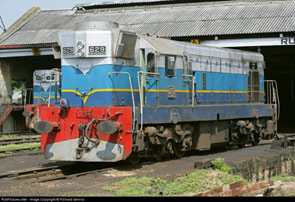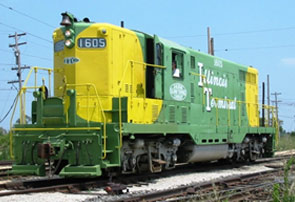| Can EMD Locomotives make a Comeback on Sri Lankan Rails? |
| |
 |
| The Legendary M2 Locomotive |
|
|
Mention the Class M2 locomotive in Sri Lankan railway circles and railwaymen and rail fans alike will run out of superlatives in heaping praise on this iconic piece of machinery. Their advent on the island’s rails way back in 1954 heralded a new era in the history of rail transportation in the country. The first five locomotives came as aid from Canada under the Colombo Plan. Due to their exceptional performance more were ordered later, until the class grew to a strength of fourteen. Much has been said and written on this class of locomotive than on any other class and it is futile echoing oft-repeated facts here. |
| Suffice it to say that after sixty years barring one or two due to accidents, the rest in the class are all still going strong to this day, a glowing tribute to their manufactures. |
| |
|
|
| It is pertinent to explore the origins of this locomotive and its rise to fame. As is well known the M2s were manufactured by the Electro Motive Division (EMD) of General Motors (of Canada in this instance) and is the export version Model G12 of their famed GP7 locomotive. General Motors of US had revolutionised the American railroads and indeed the world’s with the introduction of diesel rail traction in the 1930s, which ultimately led to the demise of the steam locomotive on a worldwide basis. The war years of the 1940s proved a temporary setback to locomotive development. After the war railways throughout the world were struggling to keep their steam locomotive fleets operating due to their excessive maintenance requirements and difficulties in obtaining good quality coal. The post-war years saw most railroads looking to diesel traction, although some, notably in Europe turned to full scale electrification. It was then that Richard Dilworth, an engineer at EMD, came out with the GP7 in 1949. |
| |
|
|
| The GP7 (GP standing for ‘General Purpose’) was a complete departure from the earlier streamlined nose ended locomotives and consisted of a long narrow hood housing the main machinery with the cab at one end and a shorter hood for the controls in front of the cab. Thus was born the now familiar and well known hood type or ‘road switcher’ type as is termed in North America. It was a four axle unit with EMD’s well proven two stroke 567 engine with the 16 cylinder version developing 1,500hp and was intended mainly for branch line use. Dilworth made the locomotive as simple as possible. |
|
 |
| EMD GP7 Locomotive |
|
|
However he introduced a number of improvements such as better quality insulation on the traction motors permitting higher short and long term ratings leading to greater tractive effort and a throttle which offered instant engine response.
All this of course was backed up by EMD and GM’s traditional quality and workmanship. The GP7 was a tremendous success with railroads all over America and soon they were clamouring for more powerful units for main line use, but of the same road switcher type configuration. The rest, one might say, is history. EMD went on to make the ‘Special Duty’ or six axle SD version topping off with the gigantic 260 ton eight axle DDA40X of 6,600hp, and dominated the world diesel locomotive scene for nearly five decades.
For export, EMD offered the G series, the G12 having the 12 cylinder 567 series engine of 1310/1425hp as found in the M2s. The G12s had all the advantages of the epoch making GP7 and could be readily adopted for any gauge from 3ft to 5ft 6ins as in Sri Lanka. Outside the US, they were manufactured in Canada and in Australia. Over a 1000 units were produced for worldwide use. The locomotive became a legend due to its performance and durability. Of course the M2s are a testimony to this accolade, crowned “the best performing locomotive in Sri Lanka”. Leaving aside performance, no one who has encountered them, would fail to be impressed by their characteristic two stroke deep throb and musical triple wind horns. Apart from Sri Lanka, G12s are said to be still in active service in countries such as Australia, Taiwan, Israel and Norway. Even some GP7s are known to be operating in a few remote corners of North America. It is not known if any other class of diesel locomotive has survived for so long and in such numbers as the GP7 and G12.
With all this history behind the M2, one might wonder why Sri Lanka is yet to see another class of EMD locomotive on its rails. The Class M6 Henschel and M7 Brush locomotives do have EMD 645 engines and have performed admirably. However they cannot be considered in any way as EMD products. Unfortunately a developing country such as Sri Lanka has to frequently suffer vagrancies in relation to securing scare foreign resources for acquisition of machinery and capital goods. Often they have little choice when having to rely on lines of credit offered from donor countries and need to settle on whatever is offered. It is stated that in 2000, the ill-fated M9s were accepted under dubious circumstances over a competitive bid from GM, EMD. The last chance of ever seeing another class of EMD locomotive on Sri Lankan rails may have gone forever with this sad episode!
What about EMD itself, how have their fortunes panned out? In the 1980s with the pressures of the world economy bearing down on them and in the face of declining revenues, mighty GM started concentrating less on their locomotive business and more on their automobiles. As far as EMD were concerned, GM were sitting on their laurels with innovation and improvement taking a back seat. The unthinkable then happened. Reliability and quality, which were hallmarks of EMD began slipping, the SD50 and SD60 locomotives for North America being a case in point. Many railroads which were diehard EMD adherents began overlooking them for new locomotive acquisitions. This was when General Electric (GE), the company founded by Thomas Edison in the late 1800s, stepped in. Previously they had played second fiddle to EMD in the locomotive market. But now they adopted an aggressive strategy, improved quality and above all, incorporated state of the art technology and electronics in to their locomotives. Reliability and efficiency of their machines increased by bounds. GE Dash 8s and Dash 9s were selling in their thousands. In the early 1980s they overtook EMD and became the number one locomotive builder in the world, a position they have maintained to-date.
Unfortunately for EMD, things went from bad to worse. A few years ago GM sold off EMD. They are now wholly owned by Caterpillar, the giant earth moving machinery manufacturer. No longer is EMD the proud Electro Motive Division, but “Electro Motive Diesels”, still entitled to the renowned EMD acronym, their number one tag long gone. However, they are attempting to claw back the lost markets. In the 1990s EMD had introduced the first AC drive diesel electric locomotive, the SD70MAC. The improved version SD70ACe of 4,300hp is selling well, with large numbers operating on private iron ore railroads in Australia. Many DC drive 3,000hp locomotives, the model JT42CW, have been purchased by European railways including the UK. Collaborative agreements with countries such as China and India have seen the transfer of technology leading to the manufacture of EMD locomotives in those countries. China assembles an immense 6,000hp locomotive.
|
| |
|
|
 |
| Indian DLW built EMD Locomotive |
|
|
India’s Diesel Locomotive Works (DLW), traditionally an ALCO stronghold, manufactures 4,500hp AC drive locomotives. Sadly, the Canadian manufacturing facility in London, Ontario, where the M2s originated, has closed down with EMD manufacturing only in Indiana in the US. However, the initials EMD still hold a fascination for rail fans worldwide. There is magic in the name, there are more EMD fans in the world than those for other makes! |
|
With this backdrop in mind, what chances are there of seeing another model of EMD locomotive on Sri Lankan rails? Prior to attempting to answer this question it is worthwhile pondering very briefly on the status of locomotives in the island. Since the M2s, the country has seen a diverse range of locomotives. Of these, some classes have fared miserably and are already defunct. True enough, classes such as the M4, M6 and M7 have soldiered on for decades thanks to the ingenuity of the railway staff. In recent times long distance expresses have been in the hands of the ubiquitous Diesel Multiple Units (DMUs) leaving locomotives for other passenger and freight services. The country cannot afford the luxury of employing different types of locomotives for different duties, but needs versatile mixed traffic machines that will be equally at home with stopping passenger trains through freights to crack expresses. The Indian DLW built ALCO M8s and M10s are rugged machines of simple, but proven technology, albeit, to an obsolete US design. The great Indian railways have been dominated by similar ALCOs for years. The M8’s and M10’s power of 2,000+hp renders them ideal for the heaviest work. Unfortunately their weight and wheelbase preclude their use on the Up Country line, in common with the M4. Thus it is no wonder there is still no equal to the legendary M2, despite its lower power!
From EMD’s current range of locomotives, it appears they are concentrating only on high horse power models, in the range of 4,000+hp. This is the case with Indian DLW built models as well. Unfortunately, currently there does not appear to be any EMD models around the lower 2,000hp mark which seem suitable for duties up to the most arduous tasks in Sri Lanka. Even if the country were to resort to calling competitive bids, EMD would most certainly not be in a position to offer an appropriate machine. The sad conclusion therefore is that it is highly unlikely that EMD will make a comeback on Sri Lankan rails!
Thus it is all the more reason why the railways of Sri Lanka need to hang on to the M2 and ensure it rolls along for many more years. Given the dedication and skills of the railway staff there is no doubt that this could happen, after all, it is the legendary EMD workhorse that has thrilled and served excellently several generations of rail passengers in Sri Lanka!
| References: |
| |
EMD Early Road Switchers, GP7-GP20 Locomotives, Brian Solomon, Speciality Press, 2006 |
| |
The Dilworth Story, Franklin M Reck, McGraw-Hill Book Company, 1954 |
| |
EMD Official Web Site |
|
| |
|
|
|
|